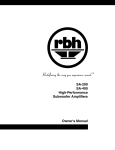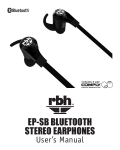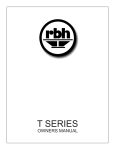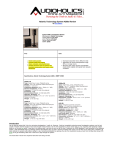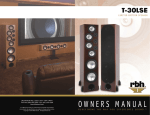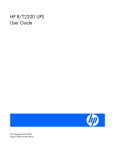Download RBH Sound RBH 180 Owner`s manual
Transcript
SA-200 / SA-400 High-Performance Subwoofer Amplifier Owner’s Manual Introduction Congratulations on your purchase of an RBH Sound Subwoofer Amplifier! Your RBH Subwoofer Amplifier is the result of many years of research and development dedicated to producing high quality power amplification for home audio subwoofer systems. This manual contains operating procedures for the RBH SA-200 and SA-400. It is recommended you thoroughly read the material contained in this manual before making any connections to your subwoofer amplifier. This will ensure you have a good understanding of how to set-up and operate your subwoofer amplifier for optimum performance. Front Panel The following are descriptions of the front panel functions (refer to figure 1). NOTE: When buttons are pushed in they are in the “on” position. 1. Power Button: This button allows the amplifier to be turned on and off manually or when kept in the “on” position and the Auto Button (see figure 1, #2) is kept in the “on” position; the amp will automatically turn on when it detects an incoming audio signal. The power indicator light above the power button will glow when the amplifier is on. IMPORTANT! The volume control should be set at the minimum setting (all the way counter-clockwise) before plugging the amplifier into an A/C wall outlet. 2. Auto Button: This button, when in the “on” position, allows the amplifier to automatically turn on when there is an incoming audio signal present at either the “Line” inputs or “From Receiver/Speaker Level” inputs. For this function to work properly, the Power Button must be left in the “on” position. The light above the Auto Button will glow when the unit is in “standby” mode. No other lights will glow. 3. Boost: This button, when in the “on” position, will increase output at 25Hz by 4dB. Use this button with discretion and caution as some subwoofers may not be able to handle this extra boost. RBH does not recommend using this feature with the following RBH products: SI-10, TS-10AN, or MCS-88. 4. Phase Control: This knob changes the output phase of the amplifier. Changing the phase will change the way the subwoofer(s) and main speakers interact with each other at the crossover frequency. Typically, this will be set to the 0° position. To operate, press then release the phase button. While it is extended, adjust as necessary if any problem between the subwoofer and main speakers exist. Press the button back in. 1 Front Panel (continued) 5. Crossover: This button allows the amplifier’s internal low-pass filter to be defeated when using an external crossover, or when the crossover is not needed. When defeated (off), the subwoofer output will play the full-range of the audio signal. This button has no effect on the high level inputs and outputs shown in figure 2, #10 and #11. The high level output (figure 2, #10) has a 100Hz high pass filter and is not adjustable or defeatable. 6. Crossover Frequency Control: The variable crossover frequency control allows you to set the point of the low-pass frequencies being reproduced by the amplifier anywhere from 40Hz-180Hz. Try an initial setting of the crossover frequency control at the midway (12 o’clock) setting. Increasing the crossover frequency will produce more mid-bass output from the amplifier. 7. Master Volume Control: This dial allows you to adjust the output level of the subwoofer to match the audio system. For an initial setting, turn the volume control up one quarter of a turn (9 o’clock) position). The volume control may be adjusted while listening to match the subwoofer output level with the rest of the system. REMINDER–The volume control should be at the minimum setting (all the way counter-clockwise) before plugging the amplifier into an A/C wall outlet. Figure 1 Front Panel View 2 Rear Panel The following describes the control functions of the rear panel of the amplifier (refer to figure 2). 8. Line/LFE Input: These RCA type terminals are for the pre-amp level input signals coming from a processor or preamplifier labeled “subwoofer” or “LFE.” IMPORTANT! Use either the Line Level inputs or the “Speaker Level” inputs separately. DO NOT use both, as damage to the receiver and/or the Subwoofer Amplifier may result. WARNING! DO NOT connect an amplified or speaker-level signal into the line/LFE input(s). 9. Line/LFE Output: These RCA type terminals carry the same audio signal as the line inputs. These terminals are used if an output signal is needed elsewhere in your system. These outputs are full-range outputs. 10.Speaker Level Output: This 100Hz high-pass speaker output is for your satellite/main speakers. The built-in crossover limits the frequencies below 100Hz from being sent to your satellite/main speakers. You may use these speaker outputs only when using the “Speaker Level” input terminals (#11). Connect your satellite/main speakers (observing the proper polarity) to the binding posts labeled “Speaker Level Out.” NOTE: These connectors are not powered by the Subwoofer Amplifier. 11. Speaker Level Input: These connectors are for the amplifier or speakerlevel audio output from an amplifier or receiver. IMPORTANT! Use either the Line inputs or the “Speaker Level” inputs separately. DO NOT use both, as damage to the receiver and/or the Subwoofer Amplifier may result. 12.Subwoofer Output: This is the amplified audio output of the Subwoofer Amplifier. If the Crossover Button (#5) is in the “on” position, the audio output will be limited to the lower frequencies selected by the Frequency Control (#6). If the Crossover Button (#5) is in the “off” position, the audio output will be full-range. An impedance load of 4-16 ohms may be connected to this output. Please follow the instructions in the connections section of this owner’s manual for proper wiring information. 13 Dimmer: This knob adjusts the brightness of the indicator lights on the front panel. 3 Rear Panel (continued) 14.Fuse Access: This is the power fuse access. WARNING! In the event the fuse must be replaced, the replacement fuse must match exactly the original fuse value. If the replacement fuse is not of the same value, damage to the Subwoofer Amplifier may result. CAUTION! Before replacing the fuse, disconnect the power cord from the power receptacle. 15.Voltage Selector Switch: If your model features this capability, this switch allows you to select between 110V A/C (60Hz) or 220V A/C (50Hz). WARNING! If the voltage setting does not match the A/C power supplied, damage to the Subwoofer Amplifier may result. 16.Power Cord Receptacle: The supplied power cord needs to be connected to this receptacle in order for the Subwoofer Amplifier to work properly. WARNING! Make certain that you are using the proper power cord and voltage selection for the type of A/C power supplied. Figure 2 Rear Panel View 4 Connections System One: Using line level inputs. NOTE: Speaker-level inputs are not used in this system. System Two: Using speaker level inputs. NOTE: Line level inputs are not used in this system. NOTE: This example is for speaker level input only. DO NOT connect the left and right satellite speakers to the amplifier if the line inputs are used. 5 Troubleshooting Situation: Probable Cause: Solution: No sound from the subwoofer(s) Amplifier is not connected to constant A/C power outlet. Make certain the amplifier is plugged into an unswitchable A/C power outlet Subwoofer(s) is/are not connected to the amplifier correctly Make certain that subwoofer(s) is/are connected properly (refer to the connections section of this manual) Amplifier is not receiving an audio signal for the pre-amp/receiver Maker certain there is an audio signal from preamp/receiver and audio connections resemble those in the connections section of this manual. Electrical short in wiring Verify that all connections are complete and secure, with no stray wires contacting other terminals. Amplifier fuse might be blown Replace fuse (if fuse is not readily accessible, consult your authorized RBH dealer). WARNING: Before replacing fuses, please see the rear panel features/ controls section (Figure 2, #14) of this manual. Bad connection(s) to nonworking subwoofer(s) Verify all wires are properly connected. Electrical short in wiring Verify that all connections are complete and secure, with no stray wires contacting other terminals. If problem is in wire itself, replace the suspect wire. If one subwoofer is damaged due to being overdriven, then it may have a negative effect on another subwoofer used in a series connection. Check each individual subwoofer to verify each is still operational Sound from at least one subwoofer, but not the other(s) 6 Troubleshooting (continued) Situation: Probable Cause: Solution: Performance is less than expected The + and – polarity of the subwoofer wire might be reversed on the subwoofer Check the entire system for proper polarity Crossover frequency is not adjusted correctly Adjust crossover frequency by turning the Crossover Frequency Control clockwise until desired sound is obtained Crossover button is in the wrong position Check Crossover On/Off button for correct setting 7 Specifications Model SA200 SA400 Amplifier Type: Discrete Class A/B Discrete Class A/B Recommended/ Rated Power: 200 Watts (RMS @ 4 Ohms) 400 Watts (RMS @ 4 Ohms) Maximum Power Consumption: 400 Watts 800 Watts Distortion (THD): < .04% @ 1 Watt < .03% @ 1 Watt S/N Ratio: >82dB (without filter) >84dB (without filter) Input Impedance: 47 KOhms (line level) 200 Ohms (speaker level) KOhms (line level) 200 Ohms (speaker level) Input Sensitivity: 80mV (line input) 80mV (line input) 280mV (speaker level) 280mV (speaker level) Crossover Slope: 12dB/octave 12dB/octave Crossover Frequency Range: 40Hz–180Hz ±3dB (variable) 40Hz–180Hz ±3dB (variable) Auto Turn-on Sensitivity: 1.8mV 1.8mV Turn-off Delay Time: 15-20 minutes 15-20 minutes Frequency Response: 20Hz–20kHz ±3dB (crossover off) 15Hz–20kHz ±3dB (crossover on) 20Hz–20kHz ±3dB (crossover off) 15Hz–20kHz ±3dB (crossover on) Boost: ±4dB @ 25Hz (when activated) ±4dB @ 25Hz (when activated) Damping Factor: >200 >200 Chassis Color: Black Black Cutout Dimensions: Rack Mount Holes (Center to Center) Horizontal 18¾” (476mm) Vertical 3” (76mm) Rack Mount Holes (Center to Center) Horizontal 18¾” (476mm) Vertical 3” (76mm) Dimensions: 17” W x 4” H x 13” D (w/o rack) (450mm W x 101mm H x 355mm D) 19” W x 4” H x 14” D (with rack) (482mm W x 101mm H x 355mm D) 17” W x 4” H x 13” D (w/o rack) (450mm W x 101mm H x 355mm D) 19” W x 4” H x 14” D (with rack) (482mm W x 101mm H x 355mm D) Weight: 17 lbs. (7.71 Kg) 25 lbs. (11.34 Kg) 8 Safety Instructions CAUTION! DO NOT open the amplifier, attempt any modifications or repairs. There are extremely high voltages present and any servicing must be referred to RBH Sound or an authorized qualified technician. ATTENTION! Opening the amplifier will void warranty. WARNING! To prevent shock or fire hazard, never permit moisture or any liquid to get into the amplifier. If an accidental spill occurs, immediately shut off the power, unplug its A/C power cord and seek a qualified technician for repair. CAUTION! To reduce the risk of electric shock, do not remove the cover (or back). No user serviceable parts inside: refer servicing to qualified technician. All safety instructions should be read before this amplifier is operated. Please retain these safety instructions for future reference. Adhere to all warnings on the amplifier and in this manual. Ventilation: The amplifier should be situated so that its location or position does not interfere with its proper ventilation. The amplifier should not be situated on a bed, sofa, rug or similar surface that may block the ventilation openings, nor should it be placed in a built-in installation such as a bookcase or cabinet that may impede the flow of air through the ventilation openings. Power Source: The amplifier should only be connected to a power supply of the type described in this instruction manual or as marked on the amplifier. Precautions should be taken so that the grounding or polarization means of the amplifier are not defeated. Power Cords: Power supply cords should be routed so that they are not likely to be walked on or pinched by items placed upon or against them, paying particular attention to wall receptacles and the point where they exit from the amplifier. Object and Liquid Entry: The amplifier should not be exposed to dripping or splashing and objects filled with liquids, such as vases or plants, should not be placed on top of or next to the amplifier. Care should be taken so that objects do not fall and liquids are not spilled into the enclosure through its ventilation openings. Damage Requiring Service: This amplifier should be serviced by a qualified technician when: —The power supply cord has been damaged; or —Objects have fallen or liquid has been spilled into the amplifier; or —The amplifier does not appear to function normally or exhibits a marked change in performance; or —The amplifier has been dropped or the enclosure is damaged. 9 Warranty Your RBH Sound SA-200/SA-400 is covered by a limited warranty against defect in materials and workmanship for a period of one year from date of purchase. This warranty is provided by the authorized RBH Sound dealer where the SA-200/SA-400 was purchased. Warranty repair will be performed only when your purchase receipt is presented as proof of ownership and date of purchase. Defective parts will be repaired or replaced without charge by your dealer’s store or the location designated by RBH Sound authorized to service RBH Sound products. Charges for unauthorized service and transportation cost are not reimbursable under this warranty. This warranty becomes void if the product has been damaged by alteration, misuse or neglect. RBH Sound assumes no liability for property damage or any other incidental or consequential damage whatsoever which may result from the failure of this product. Any and all warranties of merchantability and fitness implied by law are limited to the duration of this expressed warranty. Some states do not allow limitations on how long an implied warranty lasts, so the above limitations may not apply to you. Some states do not allow the exclusion or limitation of incidental or consequential damages, so the above limitation or exclusion may not apply to you. Redefining The Way You Experience Sound. TM 382 Marshall Way, Layton, Utah • USA • 84041 Toll Free: (800) 543-2205 • Fax: (801) 543-3300 www.rbhsound.com It is RBH Sound policy to continuously incorporate improvements into products; all specifications are subject to change without notice. Copyright © 2007 RBH Sound. All Rights Reserved.













